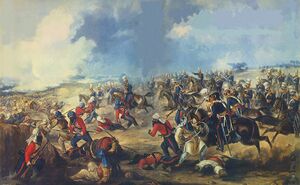Battle of Narkaner: Difference between revisions
No edit summary |
No edit summary |
||
| Line 37: | Line 37: | ||
{{flagicon image|AurucoliaFlagOne.png|22px|border=no}} [[Sandoric Aurucolia]] | {{flagicon image|AurucoliaFlagOne.png|22px|border=no}} [[Sandoric Aurucolia]] | ||
* [[Aurucolian East Indiae Company]] | * [[Aurucolian East Indiae Company]] | ||
| combatant3 = | | combatant3 = | ||
| commander1 = {{plainlist| | | commander1 = {{plainlist| | ||
Revision as of 16:50, 15 February 2021
The Battle of Narkaner (15 February - 20 March 1821) was an engagement that took place at the village of Narkaner. The battle would see the Coalition Forces suffer their greatest defeat, almost losing 40% of their combined strength in the war. The battle was dubbed as The Grim March because of the amount of losses that the Lucians and Galbadians suffered. It would also be Lucis' biggest defeat in history, losing almost 60% of its total strength. As opposed to the Aurucolians and Sikhs, who only lost 1/5ths of their original strength.
The reasons for the losses was in root that Kisbátor fainted a mass retreat on 5 March 1821. Galbadian General Georg Ludwig Koppel saw this as an opportunity to route the army and requested Humeray to commit his forces. However, the retreat was a trap, which saw Dobos' Aurucolian forces to cut off both the Lucians and Galbadians. A fight to escape the encirclement ensues. The grand encirclement made Humeray realize that his army was in danger of being destroyed entirely. Immediately, he sends General Johannes Vandemeer to engage Dobos' Army to open a corridor so Humeray can withdraw his forces. Meanwhile, Koppel ordered De Gama to force a corridor and fight a way out since he refused to commit the colonials to relieve the encircled Galbadian forces. For the next days, the Sikhs and Aurucolians inflicted massive casualties against the Galbadians and Lucians. But due to the timely arrival of Vandemeer's Cape Basel Colonial Army, the Sikhs and Aurucolians failed to destroy both the Lucian and Galbadian Armies in the region, which was the intended objective to allow Kisbátor to thrust towards Central Indiae.
The Battle marked the end of the Lucis rule in Central Indiae for the rest of the year. But despite it, the Sikhs and Aurucolians did not complete their intended objectives, and that 60% of the Lucian Army managed to successfully withdraw. Despite it, the battle raised the morale of the Aurucolians and Sikhs tremendously, with most of the commanders having in mind that they were winning the war, and that it would only be a matter of time before Lucis and Galbadia surrenders.
As a result, General Benedict Humeray and Koppel were forced to depend on the natives to raise their armies respectively. However, the loss at Narkaner provided General Benedict Humeray with a strategy to overturn the Aurucolians and Sikhs by the time the the latter invaded Southern Indiae.
